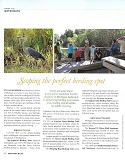Scoping the Perfect Birding Spot

By Dianna Stampfler
It’s no surprise that the woods and waters of Michigan are home to more than 400 species of birds. From the endangered Kirtland’s Warbler and Great Lakes Piping Plover to the majestic Bald Eagle, these winged creatures draw crowds hoping to get a glimpse of them in their natural habitat.
Birding is the second fastest growing hobby in the United States says the U.S. Fish & Wildlife Service, and here in Michigan there are more than two million resident birdwatchers. In fact, there are some three dozen active Audubon Chapters in Michigan dedicated to preserving birding ecosystems and creating opportunities for public viewing.
Currently there are five defined birding trails around Michigan, with several others in various phases of development.
The Superior Birding Trail covers 150 miles in the Upper Peninsula, from the Seney National Wildlife Refuge to Paradise—home of the Whitefish Point Bird Observatory. Over 300 species of birds have been recorded in this region.
Encompassing more than 145 miles along US-23, the Sunrise Coast Birding Trail stretches along the Lake Huron shoreline from Mackinaw City to the mouth of the AuSable River in Oscoda where common, threatened and endangered birds have been spotted.
Located entirely on Lake Michigan’s largest island—Beaver Island—the Beaver Island Birding Trail spans 12,000 acres of natural habitat, where as many as 250 bird species can be found.
Commonly referred to as the SBBT West, the Sleeping Bear Birding Trail boasts 250-plus species along its 123-mile stretch, from Manistee to Traverse City, along the scenic M-22 highway and the Lake Michigan shoreline.
The SBBT East, otherwise known as the Saginaw Bay Birding Trail, takes travelers along the Lake Huron shoreline for 142 miles from Tawas Point State Park south to Port Crescent State Park. Be on the lookout for the 200 bird species that call this area home.
Michigan is also home to countless bird sanctuaries that offer informational programming and viewing opportunities.
The Bernard W. Baker Bird Sanctuary consists of some 900 acres including over two miles of walking trails in Calhoun County. The sanctuary is dominated by the large 200-acre Big Marsh Lake, which provides a rich habitat for over 200 bird species.
The 1000-acre Phyllis Haehnle Memorial Sanctuary in Jackson County attracts thousands of migrating Sandhill Cranes each fall. More than two miles of trails take visitors through natural habitats where over 200 bird species can be found.
Michigan State University’s W.K. Kellogg Bird Sanctuary is one of North America’s pioneer wildlife conservation centers. It offers 180 acres of diverse habitats along the 40-acre Wintergreen Lake in Augusta (between Kalamazoo and Battle Creek). Nearly two miles of trails, some wheelchair accessible, allow visitors to see hundreds of waterfowl in their natural habitat including trumpeter swans. A “Birds of Prey” enclosures features rehabilitated species, including a bald eagle, red-tailed hawks, Eastern screen owls and more.
Originally landscaped as an arboretum, the 76-acre Lake Bluff Bird Sanctuary in Manistee County includes 1500 feet of Lake Michigan frontage. Hundreds of birds take up residence in the towering California Redwoods, Ginkos, Giant Sequoias and Sycamores that line 1.5 miles of trails. A cozy Bed and Breakfast is the perfect respite for visitors wishing to extend their birdwatching experience.
Located on 128 acres in Barry County, the Otis Farm Bird Sanctuary is made up of rolling fields, mature forests and expansive marshlands that are home over 165 species of birds—including several that are rated rare and endangered.
As Michigan’s northern-most birding sanctuary, the Whitefish Point Bird Observatory in Paradise conducts two of the longest-running point counts in North America. The site, located next to the Shipwreck Museum and Whitefish Point Light Saving Station, is a globally-significant migration funnel for raptors, waterbirds, shorebirds and passerines.
For a list of other bird sanctuaries around the state, visit the Michigan Audubon Society website at michiganaudubon.org. A list of birding festivals and events can be found in the Excursions section, starting on page _______ (and in future issues, throughout the summer and fall months).
Reprinted from the Spring 2016 issue of Michigan BLUE Magazine.
